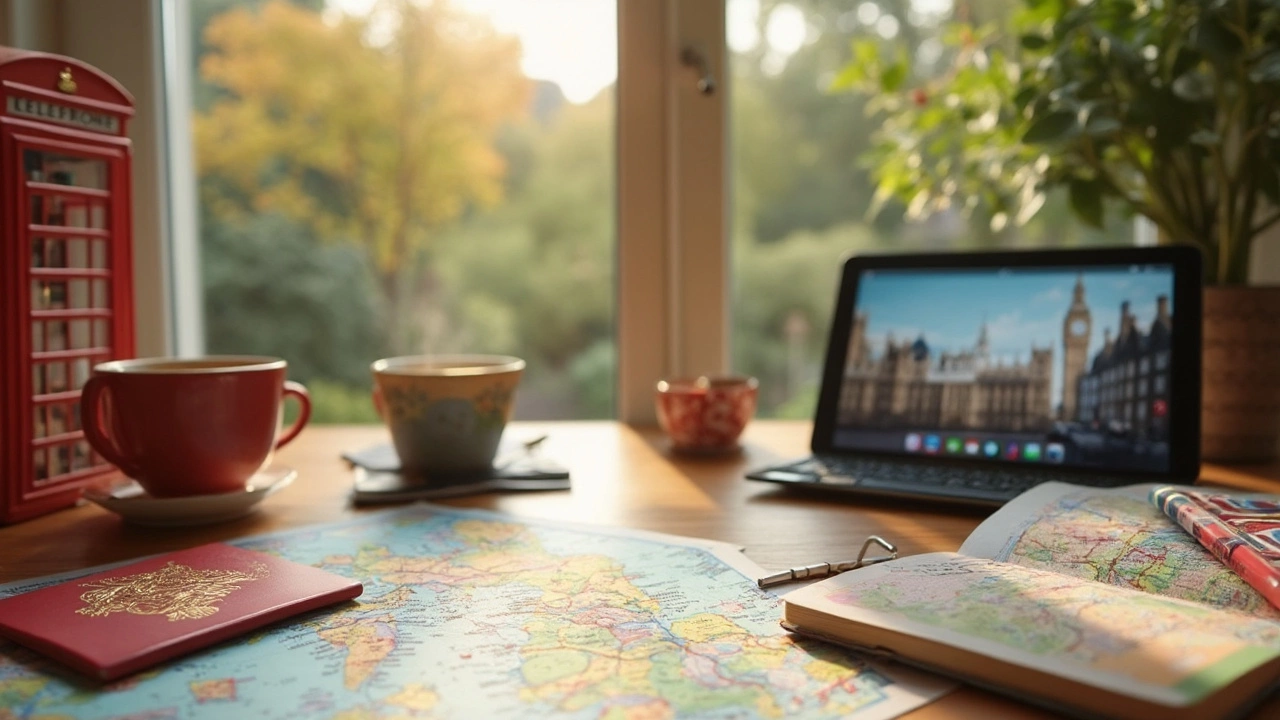Ever wondered why England attracts so many travelers? It’s a mix of ancient castles, buzzing cities, cute villages, and the fact that you can get from a royal palace to sheep-filled hills in under two hours. Unlike planning a beach vacation, an England trip can feel a little overwhelming because there’s just so much to see in a small place. I get it. Before my first trip, I was lost in tabs, back-and-forth messages with Archer, and way too many guidebooks.
First thing—don’t book anything until you check your passport. If you’re coming from the US, Canada, or most EU countries, you don’t need a visa for stays under six months, but your passport needs to be valid for the duration of your stay. Set calendar reminders to renew yours way before you even start scouting flights, because nothing crushes excitement faster than passport panic.
Now, about timing. Summer sounds fun, but the crowds in places like London and Bath can make you want to run for the hills—literally. May and September are a sweet spot. The weather’s mild, gardens bloom, and prices aren’t sky-high. If you love all things cozy—think pub fireplaces and afternoon teas—don’t rule out autumn. The countryside turns every shade of orange and there are fewer people jostling for the perfect selfie at Stonehenge.
- Figuring Out When to Go and What You Need
- Choosing Where to Stay and How to Get Around
- Mapping Out Must-See Places
- Money Matters and Booking Tips
Figuring Out When to Go and What You Need
Choosing the best time to visit England can totally change your trip. Let’s get this out of the way: the weather in England is famous for being moody. Summers (June to August) are the busiest and usually don’t get hotter than 25°C (77°F), but popular spots like London, Oxford, and Cambridge get packed. If you want warmer days but fewer crowds (and lower prices), aim for late spring (May) or early autumn (September). Winter isn’t as harsh as some people think, but it does get dark early, and a lot of smaller attractions might be closed from November through February.
Here’s a handy breakdown, especially if you’re planning your trip to England around specific events:
- Spring (March-May): Flowers everywhere—Kew Gardens in London is stunning. Mild weather, fewer tourists, festivals like Chelsea Flower Show in May.
- Summer (June-August): Major music festivals (Glastonbury, Reading), Wimbledon, and outdoor events, but hotel prices shoot up.
- Autumn (September-November): Perfect for countryside walks (Lake District is a dream). Less crowd, cozy atmosphere. Bonfire Night in November is worth catching.
- Winter (December-February): Christmas markets (Bath, Manchester) and uniquely British traditions, but more rain and shorter days. Aim for London or big cities—more stuff stays open.
Now let’s talk paperwork. For most travelers, England is pretty straightforward. If you’ve got a passport from the US, Canada, Australia, EU, or Japan, you can stay up to six months as a tourist and don’t need a prior visa. Still, every passport counts—double check yours is valid for your England vacation dates. Starting in 2025, non-EU travelers will need to complete an electronic travel authorization (ETA) before arrival—sort of like the US ESTA system. Application is online, takes just minutes, and costs around £10.
Don’t skip travel insurance. Weird stuff happens—missed flights, lost luggage, or in my case, getting stuck on a train for hours near York because of a sheep protest (yes, really). Many UK hospitals treat emergencies, but you’ll pay through the nose if you don’t have coverage. Bring a basic plug adapter (UK uses type G plugs) and check if you need a voltage converter. Most phones and laptops work fine, but hair dryers or straighteners sometimes don’t.
If you’re flying from outside the UK, think about how you’ll get from the airport. London alone has six airports, and getting into the city can take anywhere from 15 minutes to over an hour. Factor this into your travel itinerary so you don’t end up sprinting for a train at the last second. Here’s what you might expect for airport transfer times:
| London Airport | Fastest Transfer to City Center |
|---|---|
| Heathrow | 15 min (Heathrow Express train) |
| Gatwick | 30 min (Gatwick Express train) |
| Stansted | 50 min (Stansted Express train) |
| Luton | 35 min (train + shuttle) |
| City Airport | 20 min (DLR train) |
| Southend | 55 min (train) |
Lastly, keep a digital and printed copy of your bookings and documents. British stations don’t always have WiFi, and you won’t want to be stuck fumbling with your phone when you’re sleep-deprived and surrounded by jet-lagged travelers at Heathrow.
Choosing Where to Stay and How to Get Around
Picking the right place to crash can really shape your plan a trip to England experience. London is the usual go-to, and for good reason—it's packed with sights, easy transport, and tons of neighborhoods. But if you want to cut costs or get a quieter vibe, check out Manchester, York, or even somewhere coastal like Brighton. Booking early helps. Decent hotels and central Airbnbs fill fast, especially during spring and summer. If you want to splurge on something unique, consider sleeping in a countryside cottage, a former castle, or even a London double-decker bus (yep, there are a couple of those on Airbnb).
Location matters. In big cities, stay near a Tube (subway) or major train station. Saves you loads of time and hassle. In smaller places, you might get more for your money a little further from the center, but check how late buses and trains run because some towns go quiet after dark. Here’s a tip for families: Premier Inn and Travelodge hotels are everywhere, usually affordable, and have surprisingly comfy beds.
Getting around England is easier than you think—but don’t just rely on taxis and Ubers, or you’ll blow your budget. Trains connect most cities. If you’re doing a lot of hopping between towns, grab a BritRail Pass before you arrive. It lets you ride as much as you want and can save big bucks. England travel tips here: National Express and Megabus run cheap long-distance buses if you don’t mind the slower pace. Renting a car makes sense for exploring remote areas like Cornwall or the Lake District, just remember—driving here means the left side of the road and roundabouts everywhere.
| City | Avg. Daily Transit Cost | Best Area to Stay |
|---|---|---|
| London | £8 (Oyster card daily cap) | Southbank, Covent Garden |
| Manchester | £5 (Tram & Bus day ticket) | Northern Quarter |
| Brighton | £4.60 (Bus Saver ticket) | Lanes District |
Don’t underestimate the National Rail system. Even tiny towns usually have a train stop. But book tickets in advance (up to 12 weeks out) for the best fares. For day trips and the sprawling countryside, nothing beats renting a car with Archer—just double-check if your hotel offers free parking, because that’s not always a given in city centers.
"The UK is built for public transport, so don't stress about not renting a car. With an Oyster card and your phone, you can get almost anywhere," says Rick Steves, travel expert.
Download Citymapper—it's a free app that works in many UK cities and helps you figure out the fastest (and cheapest) way to get from point A to point B. It’s honestly saved so many of my trips from becoming an endless maze of bus timetables.

Mapping Out Must-See Places
England might be small compared to some countries, but don’t let the size fool you—there’s a lot packed in. When you’re thinking about how to plan a trip to England, picking the right stops can make or break your vacation. You don’t have to do it all, but a little thought makes a huge difference.
Start with what you’re actually into. Are you all about city life, or do you want rolling hills and old stone cottages? Here’s a simple way to cover the highlights without zigzagging everywhere:
- London – It’s hard to skip. There’s Big Ben, Buckingham Palace, the British Museum (free!), West End shows, and the classic red buses. If you only have a few days, focus here. A London trip tip: pre-book major sights, especially for Warner Bros. Studio Tour if you’re a Harry Potter fan—it sells out fast.
- Bath – Perfect for a step back in time. The Roman Baths are as cool as Instagram says. Try to sneak in a visit during the quieter mornings.
- Oxford or Cambridge – If old universities, rivers, and cycling students sound good, these spots are a dream. You can do either as a day trip from London.
- The Cotswolds – Imagine postcard-perfect villages and sheep-dotted hills. It’s a great way to see classic countryside. Renting a car helps, unless you go with a small group tour.
- York – Walled history, a giant Gothic cathedral, and some of the prettiest old streets (The Shambles looks straight out of a Harry Potter set). Don’t miss the York Minster climb for a killer city view.
- Liverpool or Manchester – Both are buzzing with food, music, and football. Liverpool is all about The Beatles, while Manchester’s got a gritty, artsy vibe.
Worried about travel times? You can cross the entire country in just a few hours thanks to the train network. Here’s a peek at some typical travel times to help you plan:
| Route | Time by Train |
|---|---|
| London to Bath | ~1.5 hours |
| London to York | ~2 hours |
| London to Manchester | ~2 hours |
| London to Oxford | ~1 hour |
Don’t overload your schedule. Instead, pick three or four bases and plan day trips from there. That way, you actually get to relax and enjoy the scene instead of running yourself ragged. If you use a rail pass or book tickets early, you save money and hassle too. And if you’re tight on time, London plus one or two extra stops is still a solid adventure.
Money Matters and Booking Tips
Let’s talk straight: England is fun but it’s not cheap. Getting the budget right and booking things smartly makes a huge difference. First, the currency—you're dealing with British pounds (GBP), not euros. As of today, one British pound equals roughly $1.25 US dollars, but check before you go because exchange rates move around.
Here’s the real deal: London eats up more of your wallet than other places in England. A mid-range dinner for two in London will usually run £50–£70. You can knock down food costs by grabbing meal deals from Tesco or Sainsbury’s—they’re around £4 and honestly, my go-to for lunch on day trips.
- Don’t change money at airport kiosks. Their rates are awful. ATMs in town or using a no-foreign-fee card work out better.
- Public transport, especially if you use an Oyster card in London, is way cheaper than taxis. National Railcards save up to 1/3 on trains if you’re traveling a lot between cities.
- Book major attractions online. It’s often a few pounds cheaper and lets you skip the line—saved us an hour at the Tower of London.
If you want to keep your England travel tips practical, budget at least £120 a day per person for the basics: average hotel, food, local travel, and a few paid attractions. If you’re happy with hostels or B&Bs, you can get by for less—especially outside London or big touristy places.
When it comes to booking, airlines like British Airways and Virgin Atlantic run flash sales a few times a year. Plug your trip details into Google Flights or Skyscanner, then set up alerts. For trains, National Rail usually drops advance tickets about 12 weeks before your trip—grab them then for the best price. Accommodation goes fast in summer and at Christmas, so lock in places as soon as you know your rough dates.
| Category | London | Other Cities |
|---|---|---|
| Hotel (3-star avg) | £120–£200 | £70–£120 |
| Meals | £30–£50 | £20–£35 |
| Transport (local) | £7–£15 | £5–£10 |
| Attractions | £10–£30 | £8–£20 |
Here’s something people forget: travel insurance. Accidents happen. Get a policy that covers trip delays, lost bags, and health care—NHS is free for locals, but tourists have to pay, so don’t gamble here.
And if you’re pinching pennies, look for free stuff. Museums like the British Museum and National Gallery won’t cost you a penny. Parks like Hyde Park in London or the Royal Pavilion Gardens in Brighton are totally free and worth a wander.
If you focus on these England vacation guide details now, you’ll have more money for that spontaneous Harry Potter Studio tour or a proper pub crawl in York. Worth it.









